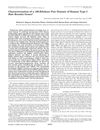TLDR K39 and K40 are the last keratins expressed in hair development, completing the hair keratin catalog.
The study identified two novel type I hair keratins, K39 and K40, which were the last to be expressed during hair follicle differentiation, completing the human hair keratin catalog with 17 members. These keratins were expressed in the upper hair cuticle and cortex, with K39 also in the upper medulla, and showed distinct expression patterns with less than 60% sequence identity to each other and other type I keratins. The research provided insights into the sequential expression and complex interplay of type I and type II keratins in different hair follicle zones during terminal differentiation.
93 citations
,
July 2006 in “Journal of Investigative Dermatology” K25, K27, and K28 are found in all inner root sheath layers of hair, while K26 is only in the cuticle.
226 citations
,
January 2006 in “International review of cytology” 92 citations
,
February 2005 in “Journal of Investigative Dermatology” 276 citations
,
January 2005 in “International review of cytology”  70 citations
,
December 2004 in “Differentiation”
70 citations
,
December 2004 in “Differentiation” The study identified and characterized new keratin genes linked to hair follicles and epithelial tissues.
49 citations
,
March 2004 in “Journal of Investigative Dermatology” 31 citations
,
January 2004 in “Methods in cell biology” 60 citations
,
December 2003 in “Journal of Investigative Dermatology” 272 citations
,
September 2001 in “Journal of Biological Chemistry” Human hair keratins were cataloged, showing their roles in hair differentiation stages.
77 citations
,
March 2000 in “Journal of Investigative Dermatology” 235 citations
,
July 1999 in “Journal of biological chemistry/The Journal of biological chemistry” Human hair is made up of different keratins, some strong and some weak, with specific types appearing at various stages of hair growth.
 74 citations
,
October 1998 in “Journal of biological chemistry/The Journal of biological chemistry”
74 citations
,
October 1998 in “Journal of biological chemistry/The Journal of biological chemistry” The 190-kbp domain contains all human type I hair keratin genes, showing their organization and evolution.
50 citations
,
July 2008 in “British Journal of Dermatology” 138 citations
,
March 2007 in “Experimental cell research” Only a few hair-specific keratins are linked to inherited hair disorders.
276 citations
,
January 2005 in “International review of cytology” 199 citations
,
January 2004 in “The International Journal of Developmental Biology” Hair follicle growth and development are controlled by specific genes and molecular signals.
29 citations
,
April 2003 in “Experimental dermatology” Human hair follicles grown in vitro maintain normal keratin patterns and structure.

